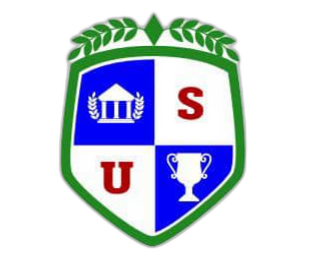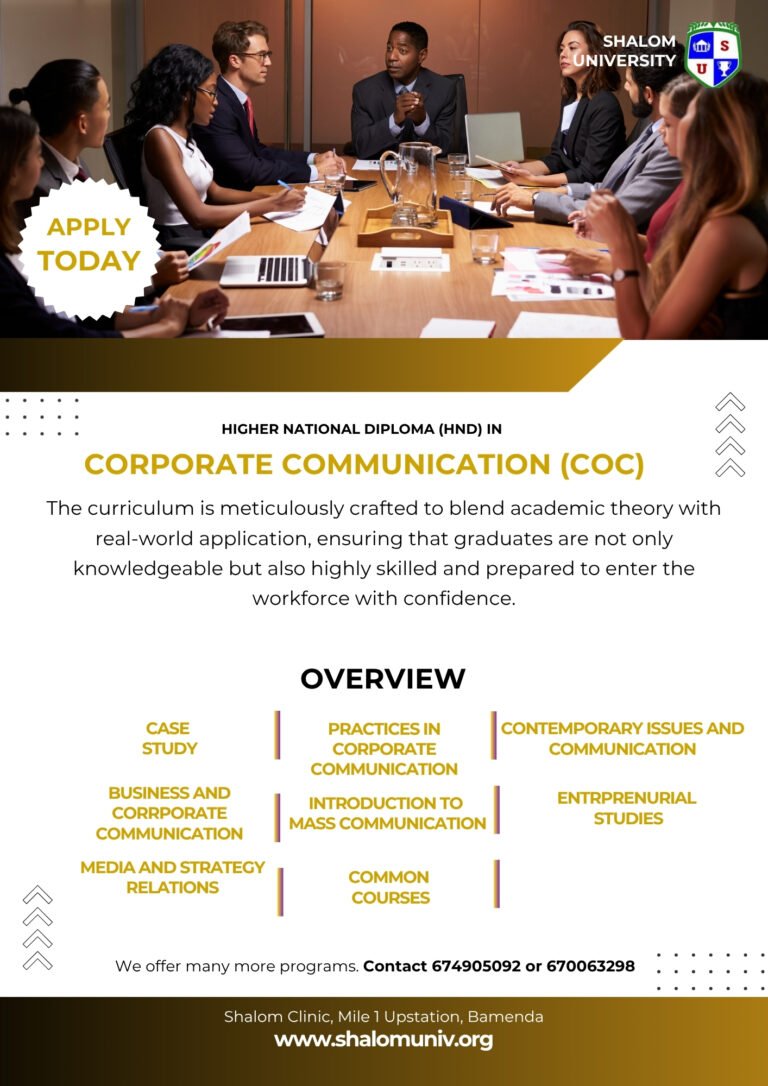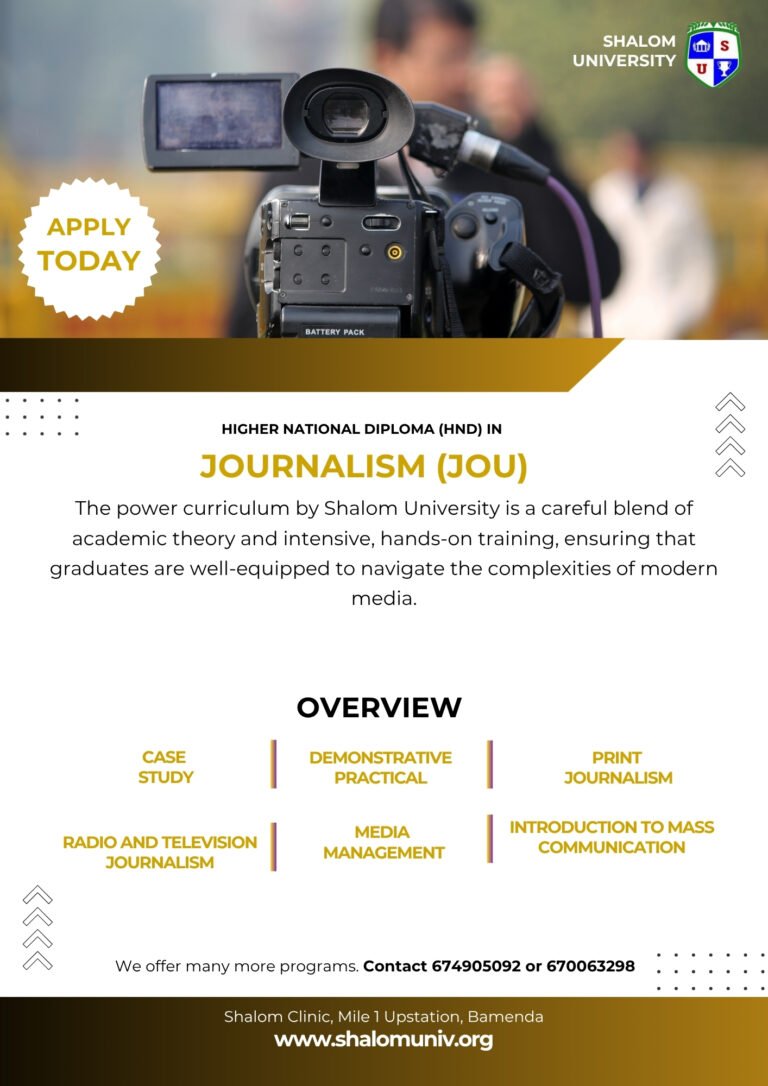In Cameroon, the visual storytelling landscape is a vibrant and powerful medium for communication, culture, and commerce. From capturing defining moments in photojournalism to producing compelling documentaries and commercial advertisements, skilled media photographers and audio-visual specialists are in high demand across a range of industries. The HND in Media Photography and Audio-Visual (MPA) at Shalom University in Bamenda is specifically designed to train these creative and technical professionals. This program provides aspiring visual storytellers with the practical skills, artistic vision, and ethical grounding needed to excel in Cameroon’s dynamic media environment.
The curriculum at Shalom University is tailored to the Cameroonian context, blending foundational media production principles with an in-depth understanding of creative processes, legal frameworks, and technical execution. Graduates are prepared not only to operate state-of-the-art equipment but also to conceptualize and produce high-quality visual content that resonates with local audiences and meets international standards.
The MPA Curriculum at Shalom University
The HND in Media Photography and Audio-Visual program at Shalom University is structured around a set of core papers that provide a comprehensive and practical education in the field.
Paper: Case Study
The Case Study paper is a vital component that integrates all the theoretical knowledge and practical skills gained throughout the program. It challenges students to analyze complex media production scenarios, from developing a visual concept for a marketing campaign to addressing ethical dilemmas in photojournalism. This is particularly relevant for media professionals in Cameroon, who must navigate diverse cultural sensitivities, resource constraints, and evolving media landscapes.
The course trains students to:
- Analyze real-world media production challenges: Based on a given case, students evaluate the creative, technical, or ethical challenges faced in a visual media project in Cameroon.
- Identify critical issues and underlying causes: They pinpoint specific problems related to visual storytelling, technical execution, budget limitations, or ethical considerations.
- Propose evidence-based solutions: Students formulate practical recommendations based on production principles, creative strategies, and legal guidelines. For example, a case study might involve a production team facing a tight deadline and budget for a documentary project, requiring a proposal for how to achieve high-quality visuals with limited resources.
- Defend their decisions: During formal presentations, students must justify their analysis and proposed solutions, demonstrating their critical thinking and communication skills, which are essential for effective production management and client interaction.
Paper: Audio-visual Law and Professional Ethics
In the modern media landscape, understanding the legal and ethical frameworks that govern audio-visual production is essential for protecting intellectual property, ensuring fair use, and maintaining professional integrity. This paper provides students with the foundational knowledge to navigate these important issues.
Key topics include:
- Copyright and Intellectual Property Law: Understanding the laws governing the use of images, sound, and video, particularly in the context of Cameroon’s legal system.
- Media Ethics: The ethical principles that guide media professionals, including truthfulness, objectivity, and accountability.
- Privacy and Defamation: Understanding the legal and ethical considerations related to privacy, defamation, and libel in visual media.
- Licensing and Rights Management: The process of acquiring and managing licenses for media content, which is crucial for commercial projects.
Paper: History and Theory of Arts
This paper provides students with a broad theoretical understanding of the history and principles of art, helping them to develop their creative vision and critical eye. Understanding art history is crucial for visual storytellers who want to create aesthetically pleasing and impactful work.
The curriculum covers:
- Art Movements and Styles: An overview of major art movements and styles, from classical to contemporary, and their influence on visual media.
- Composition and Aesthetics: Principles of visual composition, color theory, and aesthetics that inform effective visual storytelling.
- Visual Semiotics: An introduction to the study of signs and symbols in visual communication, helping students to create meaningful and impactful visuals.
- Cultural Art Forms in Cameroon: An exploration of traditional and contemporary art forms in Cameroon and their relevance to media production.
Paper: Creative Ideas
This paper is designed to foster students’ creative thinking and problem-solving skills, which are essential for developing innovative and compelling visual content. It provides students with the tools and techniques to generate and develop creative ideas for various media projects.
Key topics include:
- Idea Generation Techniques: Brainstorming, mind mapping, and other techniques for generating creative ideas.
- Visual Storytelling: The principles of visual storytelling and how to use images and sound to tell compelling narratives.
- Concept Development: The process of developing a creative concept from an initial idea to a final visual plan.
- Pitching and Presentation: Techniques for effectively pitching creative ideas to clients or project teams.
Paper: Taking Sound and Video Images
This is the hands-on, technical component of the program, providing students with the essential skills for capturing high-quality sound and video. It focuses on the practical application of equipment and techniques in a real-world setting.
The curriculum covers:
- Camera Operation: Practical experience with professional video cameras, including camera settings, framing, and movement.
- Sound Recording: Techniques for recording high-quality sound, including microphone selection, placement, and mixing.
- Lighting Techniques: Principles of lighting for video production, including three-point lighting and creative lighting setups.
- Field Production: The process of planning and executing a video shoot on location.
Paper: Photographic Shots
This paper provides students with the specialized skills needed for still photography, from capturing high-quality images to understanding the principles of photographic composition and lighting.
The curriculum covers:
- Camera Operation: Practical experience with professional still cameras, including camera settings, lenses, and accessories.
- Composition and Framing: The principles of photographic composition, including rule of thirds, leading lines, and framing.
- Lighting for Photography: Techniques for using natural and artificial light to create impactful photographs.
- Post-Production Editing: An introduction to image editing software (e.g., Adobe Photoshop, Lightroom) for enhancing and retouching photographs.
Paper: Radio and Television Editing and Mixing
This paper focuses on the post-production process for audio and visual content, from editing video footage to mixing sound for radio and television broadcasts. It provides students with the technical skills needed to finalize and polish their media productions.
The curriculum covers:
- Video Editing Software: Practical experience with professional video editing software (e.g., Adobe Premiere Pro, Final Cut Pro).
- Audio Editing and Mixing: Techniques for editing, mixing, and mastering audio for broadcast, ensuring clarity and quality.
- Color Grading and Correction: The process of adjusting color and tone in video footage to create a consistent look and feel.
- Motion Graphics and Visual Effects: An introduction to creating motion graphics and visual effects for video productions.
Visualizing Cameroon’s Story
Graduates of the HND in Media Photography and Audio-Visual from Shalom University are well-prepared to enter the workforce in various roles across Cameroon’s media and creative industries. They can serve as photographers, videographers, editors, sound technicians, or producers for news outlets, advertising agencies, production houses, and corporate communication departments. Their proficiency in capturing and editing high-quality visuals and sound, coupled with a deep understanding of media law, ethics, and creative principles, makes them invaluable assets to any organization striving for compelling visual communication. The Case Study paper ensures that they are not just technically skilled but also adept at applying their knowledge to solve real-world media production challenges. By providing a practical and contextually relevant education, Shalom University plays a significant role in nurturing the visual storytelling expertise crucial for capturing and communicating Cameroon’s unique stories to the world.



